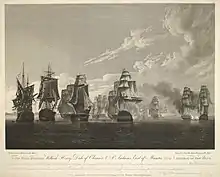_-_Intrepid_(1770)%253B_Monmouth_(1772)%253B_Defiance_(1772)%253B_Nonsuch_(1774)%253B_Ruby_(1776)%253B_Vigilant_(1774)%253B_Eagle_(1774)%253B_America_(1777)%253B_Anson_(1781)%253B_Polyphemus_(1782)%253B_Magnanime_(1780)%253B_Sampson_RMG_J3629.jpg.webp) Magnanime | |
| History | |
|---|---|
| Name | HMS Magnanime |
| Ordered | 16 October 1775 |
| Builder | Deptford Dockyard |
| Laid down | 23 August 1777 |
| Launched | 14 October 1780 |
| Commissioned | October 1780 |
| Fate | Broken up at Sheerness Dockyard, July 1813 |
| Notes | Razeed to a 44-gun fifth rate, 1795 |
| General characteristics [1] | |
| Class and type | Intrepid-class ship of the line |
| Tons burthen | 1369+51⁄94 bm |
| Length |
|
| Beam | 44 ft 4 in (13.51 m) |
| Depth of hold | 19 ft (5.8 m) |
| Propulsion | Sails |
| Sail plan | Full-rigged ship |
| Complement | 500 (as 64-gun ship); 310 officers and men (as frigate) |
| Armament |
|
_RMG_J7596.png.webp)
HMS Magnanime was a 64-gun third-rate ship of the line of the Royal Navy, launched on 14 October 1780 at Deptford Dockyard. She belonged to the Intrepid-class designed by Sir John Williams[1] and later was razeed into a 44 gun frigate.
Career
Commissioned in October 1780 under Captain Charles Wolseley, Magnanime sailed in 1781 with the Relief Expedition to Gibraltar, and subsequently to the Indian Ocean, where she participated in several of the series of battles against French forces off India – including those of Providien, Negapatam and Trincomalee in 1782 and Cuddalore in 1783. She returned to the United Kingdom and paid off into ordinary in June 1784.
From 1794 to 1795, she was cut down into a 44-gun razee fifth-rate frigate and recommissioned in November 1794 under Captain Isaac Schomberg.
On 16 March 1798 Magnanime was escorting a small convoy when she spied a privateer lurking about, seeking an opportunity to pick off a prize. Captain The Hon. Michael de Courcy set Magnanime in chase. Twenty-three hours and 256 miles later, he captured Eugénie at Latitude 42 and Longitude 12. She was armed with 18 guns, eight of which she had thrown overboard during the chase, and had a crew of 107 men. She was coppered and appeared completely new. The Royal Navy took her into service under the name HMS Pandour, but never commissioned her.[2]
On 1 April Magnanime was again involved in a successful chase. This time one of 180 miles in 18 hours. The captured privateer was the Audacieux, of 20 guns, though pierced for 22, and carrying a crew of 137 men. She too was coppered and new. de Courcy remarked that Audacieuz was so fast that if her captain had done a better job of steering she would have escaped.[2] She was taken into the Royal Navy as HMS Audacieux but apparently was never commissioned.[3]

Magnanime passed under the command of Captain William Taylor in spring 1799, and commanded her on African coast.[4][5] He took part in the capture of Gorée from the French in April 1801, while cruising with a squadron under the command of Captain Sir Charles Hamilton. Hamilton, in command of the 44-gun HMS Melpomene had received intelligence that there were three French frigates at anchor there.[6] Hamilton sailed to investigate, taking with him Taylor in Magnanime, and Captain Solomon Ferris, in command of the 64-gun HMS Ruby. The frigates were not there, so Hamilton summoned the governor and ordered him to surrender. The governor agreed, and Hamilton and his force took possession on 5 April.[6][7] Magnanime was later in the Leeward Islands, where she remained for the rest of the French Revolutionary Wars, paying off into ordinary again in 1802.[8]
During the Napoleonic Wars she served in a variety of ancillary capacities – as a floating battery, then as a hospital ship.
Fate
Magnanime was eventually broken up in July 1813.[1]
Citations
- 1 2 3 Lavery, Ships of the Line vol.1, p181.
- 1 2 "No. 15006". The London Gazette. 10 April 1798. p. 305.
- ↑ "NMM, vessel ID 380364" (PDF). Warship Histories, vol v. National Maritime Museum. Archived from the original (PDF) on 2 August 2011. Retrieved 30 July 2011.
- ↑ The Gentleman's Magazine. 1842. p. 545.
- ↑ Winfield. British Warships of the Age of Sail 1793–1817. p. 89.
- 1 2 Young. A History of the late war between Great Britain and France. p. 433.
- ↑ Norie. The Naval Gazetteer, Biographer, and Chronologist. p. 134.
- ↑ Annual Biography. p. 450.
References
- The Gentleman's Magazine. Vol. 18. London: John Bowyer Nichols and Son. 1842.
- Dodd, Charles R. (1843). The Annual Biography: Being Lives of Eminent Or Remarkable Persons who Have Died Within the Year MDCCCXLII. London: Chapman and Hall.
- Gardiner, Robert (2000) Frigates of the Napoleonic Wars. Chatham Publishing, London.
- Lavery, Brian (2003) The Ship of the Line – Volume 1: The development of the battlefleet 1650–1850. Conway Maritime Press. ISBN 0-85177-252-8.
- Norie, John William (1827). The Naval Gazetteer, Biographer, and Chronologist: Containing A History of the Late Wars, From Their Commencement in 1793 to Their Final Conclusion in 1815; and Continued, as to the Biographical Part, to the Present Time.
- Winfield, Rif (2007). British Warships in the Age of Sail 1714–1792: Design, Construction, Careers and Fates. London: Seaforth. ISBN 978-1-84415-700-6.
- Winfield, Rif (2008). British Warships in the Age of Sail 1793–1817: Design, Construction, Careers and Fates. Seaforth. ISBN 978-1-86176-246-7.
- Young, John (1802). A History of the Late War Between Great Britain and France: 1793 to 1801. Vol. 2. Edinburgh: Thomas Turnbull.
External links
 Media related to HMS Magnanime (ship, 1780) at Wikimedia Commons
Media related to HMS Magnanime (ship, 1780) at Wikimedia Commons
This article includes data released under a Creative Commons Attribution-ShareAlike 3.0 Unported UK: England & Wales Licence, by the National Maritime Museum, as part of the Warship Histories project.